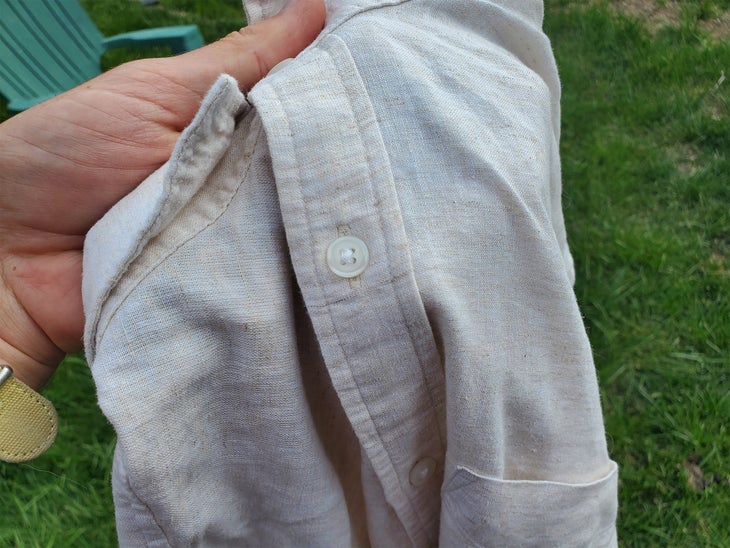Heading out the door? Read this article on the new Outside+ app available now on iOS devices for members! Download the app.
When it comes to fabrics fit for the outdoors, hikers have two options: merino or synthetics. We’ve all been told time and time again that any fabric that can’t dry out quickly or keep you warm when you’re wet isn’t worth considering.
As summer hits, I’ve been questioning this dogma. I have a closet full of nylon, polyester, and merino wool clothes, and they all work as intended. But I live in Boise, Idaho, where summers are hot and dry. Most of the summer, the trails are empty after 10 am, because the blistering heat is too much to bear. The clothes I have to pick from don’t help matters. Merino is too warm. Nylon isn’t breathable enough. And polyester is too sticky once I start to sweat. One fabric that’s performed better in hot, arid climates than all the technical options on the market? Linen.
Why linen? It’s light, airy, more durable than I expected, and sustainable to boot. But mainly, it comes down to breathability. A thin, woven linen shirt offers better airflow than just about any synthetic layer I’ve tried. There’s a reason linen is considered a classic summertime choice. The same airy, open feel that makes linen so popular at beaches and resorts holds true on a hiking trail, as well.
The perks don’t end at breathability. It’s also naturally antibacterial, and doesn’t retain hiker funk the same way that polyester does. Even the lightest linen layers I’ve tried, which are thin enough to be nearly translucent, are more durable than I expected. That’s down to the linen fibers themselves. They’re thicker, longer—and therefore stronger—than cotton fibers. The linen clothing I’ve worn seems fragile at first, but can easily stand up to abrasion from backpack straps or the occasional snag on a brushy trail.
So why don’t more people wear it hiking? Linen is easy to dismiss as a lightweight cousin of cotton, which has long been derided for outdoor use with two simple words: “cotton kills.” It comes from a different plant, but does share many of the same properties. Like cotton, linen readily soaks up water. It doesn’t dry as fast as a synthetic—though it does beat cotton in this regard. Nor will it keep you warm once it’s wet, like wool does. In short, linen has few of the perks we expect from technical fabrics. But when it comes to hot-weather apparel, I think we’ve all collectively gone overboard with our quick-drying, moisture-wicking fabric obsession.
Managing sweat and staying dry are vitally important in the cold and wet, when hypothermia is a real concern. I’d never wear linen on a winter trip, or on a thru-hike that spans the seasons. But in the middle of summer, when even overnight temperatures rarely dip below 60? Frankly, fabrics that hang onto moisture can be nice. Dunk a linen shirt in a cold stream, and it will provide much better cooling than a synthetic top that dries in under an hour. And if you do face unexpectedly cool or wet weather, you can always throw on a fleece or rain jacket.

Linen is also light on the planet. These days, it’s hard to outfit yourself for backpacking without a nagging concern about PFAS chemicals or microplastics. In comparison, linen is a natural fiber that been used to make textiles for thousands of years. Growing flax, the plant from which linen is derived, requires less water than cotton and fewer chemicals than polyester. Undyed linen is biodegradable enough that you can compost it.
That said, linen isn’t perfect. It can be a bit scratchy—as with merino wool, some people find that it irritates the skin. Its light, loose weave means it’s not the best sun protector—you’ll likely never find a linen shirt with a 50+ UPF rating. This fabric’s property, as with any piece of gear, is a trade off. UPF ratings mostly come down to thickness and density, so anything that provides stellar sun protection won’t be great in terms of breathability. A linen blend with cotton or polyester is one way to boost its UPF rating.
The biggest downside of linen is trying to find it. Most linen clothing seems to be designed for lounging on a Greek island, so options fit for a hiking trail are few and far between. The Orvis Pure Linen shirt is a solid choice that feels much like any other classic button-down hiking shirt. There are a host of collared shirts from brands like Gap and H&M, though the fit is often fashion over function. I also like Icebreaker’s Merino Linen T-shirts, which adds a bit of extra breathability compared to pure merino with a 30-percent linen blend. Sadly, linen sun hoodies are rare, and I’ve yet to find one I like.
In the end, I’m well aware that linen isn’t poised to be the next miracle fabric in the outdoors. After all, there are some good reasons we’ve moved on to other materials: It’s simply not the right choice for all conditions. But when you’re more concerned with staying cool than staying dry, linen is tough to beat.
